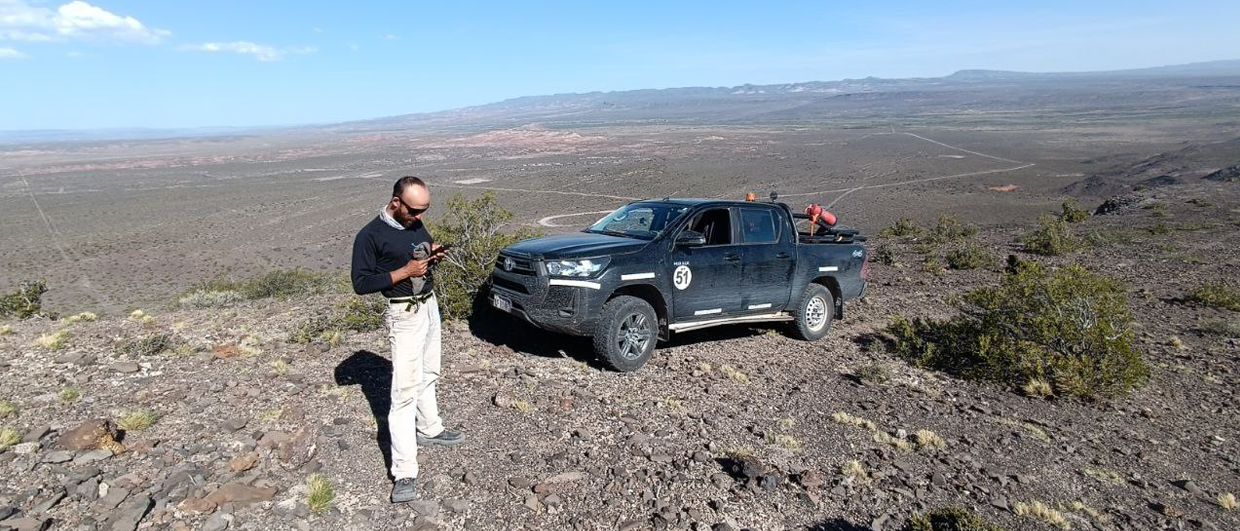The Search for a Complete Exploration Data Set
 The tight integration of GGI data with pre-stack seismic data establishes an accurate velocity/density relationship and can generate the salt surface shown in blue. Image: ARKeX2D and 3D seismic continues to be the principal geophysical technique of choice for explorationists. Advanced seismic acquisition and processing techniques, such as enhanced-azimuth acquisition and 3D pre-stack depth migration, have garnered widespread attention as operators look to generate a better subsurface understanding of increasingly complex and remote geologies.
The tight integration of GGI data with pre-stack seismic data establishes an accurate velocity/density relationship and can generate the salt surface shown in blue. Image: ARKeX2D and 3D seismic continues to be the principal geophysical technique of choice for explorationists. Advanced seismic acquisition and processing techniques, such as enhanced-azimuth acquisition and 3D pre-stack depth migration, have garnered widespread attention as operators look to generate a better subsurface understanding of increasingly complex and remote geologies.
However, conventional seismic also has its limitations, ranging from the high cost, long turnaround times, and access issues through to many areas of the world characterized by a poor seismic response.
From the sub-salt discoveries deepwater offshore Brazil and the Gulf of Mexico to the deserts and mountains of Africa, all too often the seismic wavefield is distorted and illumination irregular. The result is an incomplete ray distribution for seismic migration, a sub-optimal velocity model and lack of clarity in the sub surface image.
Advances in acquisition methods and processing techniques go some way to overcoming these limitations and whilst seismic developments will continue, the explorationist is turning to other sources of geophysical data in an attempt to reduce overall exploration risk. Data that is complementary with seismic and easily integrated into existing workflows is beginning to provide some of the answers. One such data source is Gravity Gradiometry.
The Emergence of Gravity Gradiometry
 Conventional Gravity measures ONE component of the gravity field Gz (LHS), but Gravity Gradiometry measures ALL components of the gravity field (RHS). Source: ARKeX
Conventional Gravity measures ONE component of the gravity field Gz (LHS), but Gravity Gradiometry measures ALL components of the gravity field (RHS). Source: ARKeX Conventional airborne gravity (Blue) and airborne Gravity Gradiometry (Red) response to a broadband geologic signal onshore West Africa. When combined (Yellow) best data fidelity at all frequencies is available. Source: ARKeXGravity Gradiometry Imaging (GGI), which can be acquired in airborne or marine modes, maps small density variations in underlying rocks by measuring the gradient of the earth’s gravity field.
Conventional airborne gravity (Blue) and airborne Gravity Gradiometry (Red) response to a broadband geologic signal onshore West Africa. When combined (Yellow) best data fidelity at all frequencies is available. Source: ARKeXGravity Gradiometry Imaging (GGI), which can be acquired in airborne or marine modes, maps small density variations in underlying rocks by measuring the gradient of the earth’s gravity field.
The non-invasive, passive nature of the technology allows for the exploration of vast regions quickly, accurately and cost effectively, with no adverse environmental impact.
Today, some of the world’s leading international and national operators are specifying that GGI should be part of their exploration plans. They are using GGI as an effective complimentary technology to seismic in some of their most complex and challenging geological situations. In addition to the clear cost and efficiency benefits, there are a number of other important reasons why they are graduating towards GGI.
Gravity Gradiometry provides an increased signal-to-noise ratio and wider bandwidth over conventional gravity measurements acquired from a moving platform. The response of a conventional airborne gravity system decays rapidly at higher frequencies compared to the Gravity Gradiometry system, which recovers significantly more bandwidth with increased signal-to-noise.
It can be seen however that the gravity response at lower frequencies exhibits a higher signal-to-noise ratio. Using advanced processing techniques, the signals can be combined to offer the very best data fidelity at all frequencies. The resulting high resolution and wide bandwidth data provides a 3D spatial awareness of the subsurface that can impact data at the seismic scale.
A more complete picture
 Example from the Gulf of Mexico demonstrating that where sparse 2D seismic cannot connect independently interpreted faults, GGI clearly defines the fault trend. Source: ARKeXFurthermore, compared to a conventional gravity survey which records only a single component of the gravitational force, usually in the vertical plane, full tensor Gravity Gradiometry measures all three components in all three directions.
Example from the Gulf of Mexico demonstrating that where sparse 2D seismic cannot connect independently interpreted faults, GGI clearly defines the fault trend. Source: ARKeXFurthermore, compared to a conventional gravity survey which records only a single component of the gravitational force, usually in the vertical plane, full tensor Gravity Gradiometry measures all three components in all three directions.
The problems associated with 2D seismic data are also well understood. No matter how careful the design and layout of a 2D program, there are always limitations and compromises. The inclusion of offline or sideways looking information from GGI is important to reduce the uncertainty in a 2D measurement and can provide an enhanced interpolation solution between sparse acquisition lines.
By just using sparse 2D seismic alone, two independently interpreted faults may or may not be connected, but by the addition of GGI data, the fault trend is clearly defined, as shown in the example. In short, GGI can provide a more complete picture of the fault geometry and a greater understanding of the structural fabric.
In addition, when taking any 2D seismic data to depth, it is important to understand the complex velocity field. Out-of-plane issues that could affect a 2D depth migration are difficult to resolve without any independent knowledge of the spatial context of the geology. Here, GGI can act as an intelligent 3D geologic interpolator providing valuable information at the seismic scale and helping to improve the overall subsurface image.
Let’s take a look at some examples of GGI in practice addressing complex geologies. This will take us from Africa to the Middle East, continental North America, and then to the largest continental rift system on earth.
The Issue of Salt
The increasing demand on seismic technologies to deliver over sub-salt discoveries has led to many operators looking to GGI to help.
The relatively low density of salt in comparison with typical host material and the typical morphology of salt bodies (the principal causes of problems when creating a clear sub-salt image with seismic imaging) are far better suited to being detected and then modelled using high resolution GGI. The technique can accurately map the density interface between salt and the surrounding rock and add 3D structural and velocity constraint to the otherwise interpolated fields.
The example from an onshore survey in West Africa, shows how a well constrained salt map in 3D has been developed in an area where 2D seismic data is sparse and of poor quality. Through the tight integration of GGI data with the pre-stack seismic data, the interpreter was able to establish an accurate velocity/density relationship which was then used to improve the seismic image and generate the salt surface shown in blue.
Complex Thrust Environments
 A 3D cube image linking the 2D modelled lines with a Gravity Gradiometry image, in the complicated thrust environment of the Oman Mountains, showing how the anticlines on the seismic based cross section can be traced along the Gravity Gradiometry surface. Source: ARKeX
A 3D cube image linking the 2D modelled lines with a Gravity Gradiometry image, in the complicated thrust environment of the Oman Mountains, showing how the anticlines on the seismic based cross section can be traced along the Gravity Gradiometry surface. Source: ARKeX A high resolution airborne GGI, magnetic gradiometry and LIDAR survey over the Muskwa-Kechika area of British Colombia revealed new and detailed information of geological structures over this expansive area. Source: ARKeXGGI has also been playing a key role in other geologically complex areas such as thrust belts.
A high resolution airborne GGI, magnetic gradiometry and LIDAR survey over the Muskwa-Kechika area of British Colombia revealed new and detailed information of geological structures over this expansive area. Source: ARKeXGGI has also been playing a key role in other geologically complex areas such as thrust belts.
In the Northern Oman Mountains of the United Arab Emirates, GGI was used to survey a complicated thrust environment with a poor seismic response. A series of 2D seismic lines were iteratively interpreted by integrating acquired GGI data with existing seismic interpretations and well data. The interpretation was driven by the need to match both the density profiles (guided by the gravity response) and the structurally balanced cross-sections.
The integration of the data allowed for a better understanding of the thrust linkages at different levels, and a better insight into the interaction of thrusts, backthrusts, detachment levels, imbricated zones, and lateral ramps. The high resolution GGI data also facilitated the accurate investigation of the 3D Shallow Earth Model (SEM), with the modelling of seismic sections constrained by GGI and magnetic data and producing a more geologically realistic SEM.
Another complex thrust environment is the Utah Hingeline, part of the North American thrust belt, and a trend that begins north-east of Salt Lake City and runs south-west across the state. The area’s geological complexity and sparse seismic data means that it continues to remain a challenging place for oil and gas exploration, with a need for more detailed geological information to unlock its potential.
ARKeX partnered with Houston-based JEBCO Seismic to conduct a multi-client airborne geophysical survey along the Hingeline. The main survey objective was to provide a 3D image of the anticline along which the Covenant field was discovered. The GGI data, along with supporting magnetic and digital terrain mapping (LiDAR) data, provided essential information on the location of the axis of the anticlinal structure, the depth of the fold and the presence of structural highs, the lateral continuity and quality of the prospect, the occurrence of horizontal offsets, and heterogeneities in the shallow levels.
The initial pilot was so successful that an additional 3,370 km2 of data was collected and an integrated workflow designed to highlight areas of interest for further exploration.
Finally, in the Muskwa-Kechika area of British Colombia located along the thrust front of the eastern Rocky Mountains, ARKeX partnered with JEBCO to conduct another multi-client GGI survey. The high resolution airborne GGI, magnetic gradiometry and LIDAR data was analysed and using inversion and back-stripping techniques, along with qualitative mapping of target wavelengths. This resulted in a first pass structure contour map, showing how GGI could be used as an initial screening tool to provide detailed structural information on which to plan future exploration programs.
The East African Rift System
The East African Rift System, which extends from Ethiopia in the north to Mozambique in the South, is an area of vast potential where less than 200 wells have been drilled in an area of 2.3 million km2. Many companies are now beginning to explore in the area and the need for geologic information upon which to base future exploration activities is critical. GGI is being used to map the architecture of the rift by identifying the contrasts between the basement and sediment cover. This combination of structural and stratigraphic mechanisms within the rift and the structural traps, that often develops when soft sediment drapes over the ridges and gets compacted, make it an ideal geological setting for full tensor GGI.
To date, companies, such as Tower Resources and Tullow Oil, have already seen the benefits of GGI in the Ugandan Rift System, highlighting the importance of GGI technology in this environment.
What Next for GGI? Gravity Gradiometry is now being used successfully across the world in both pre- and post- seismic acquisition – filling gaps, verifying prospects, overcoming imaging difficulties but also helping to plan and refine the locations of future seismic surveys.
The true value of GGI is only just beginning to be realised, with data integration an essential component to unlocking its benefits. By developing workflows and integrating modelling methods, GGI can sit seamlessly alongside other geophysical data within a standard interpretation and processing workflow, delivering value at various stages throughout the exploration cycle.
What is clear is that, as geophysical exploration becomes more difficult and continues to be applied to complex geologies across the world, it’s important to look beyond just the seismic!





